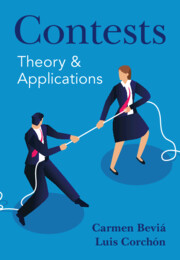Book contents
- Frontmatter
- Contents
- Illustrations
- Tables
- Preface
- Book Outline
- How to Use This Book
- Part I Foundations
- 1 An Introduction to Contests
- 2 Contest Success Functions
- 3 Equilibrium with Heterogeneous Agents
- 4 Foundations for Contest Success Functions
- Part II Extensions
- Part III Applications
- Summary: The Lost Continent – A Tale of Discovery
- References
- Index
4 - Foundations for Contest Success Functions
from Part I - Foundations
Published online by Cambridge University Press: 30 May 2024
- Frontmatter
- Contents
- Illustrations
- Tables
- Preface
- Book Outline
- How to Use This Book
- Part I Foundations
- 1 An Introduction to Contests
- 2 Contest Success Functions
- 3 Equilibrium with Heterogeneous Agents
- 4 Foundations for Contest Success Functions
- Part II Extensions
- Part III Applications
- Summary: The Lost Continent – A Tale of Discovery
- References
- Index
Summary
In previous chapters, the CSF is presented as a “black box” that encapsulates the rules and workings of the contest. This chapter explains the mechanisms behind this black box. This could include how efforts may translate, with some uncertainty, into performance, or a planner with given objectives such as designing a contest on television or procuring inputs for a firm. Additionally, the outcome of a conflict may be negotiated or decided by a jury once claims have been presented. Finally, the chapter explores the basic properties that a contest must have, such as the relationship between effort and probability of winning, and how these properties translate into different CSFs. This is known as the axiomatic approach. These different approaches are able to recover some of the main CSFs already presented in the previous chapter.
- Type
- Chapter
- Information
- ContestsTheory and Applications, pp. 50 - 62Publisher: Cambridge University PressPrint publication year: 2024

